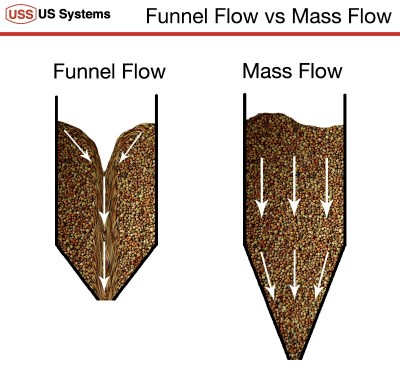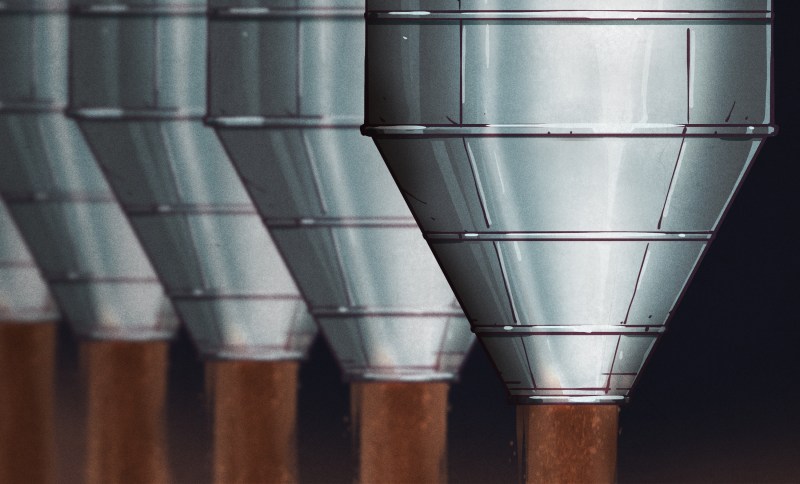Bulk material is stuff handled ‘in bulk’. One LEGO piece is a brick but 1,000 poured into a bag is bulk material. Corn starch, sand, flour, powder-coat powder, gravel, cat food, Cap’n Crunch, coins, screws, Styrofoam beads, lead shot, and gummy worms are bulk materials.
Applications abound where you need to move stuff in bulk. Selective sintering 3D printers, animal feeders, DIY injection molders, toner based PCB makers, home powder coating, automatic LEGO/domino/whatever sorters or assemblers, automated gardeners, airsoft accessories – handling bulk material is part of hacking. College science classes cover solids and liquids, but rarely bulk materials.
Most hackers just pray it works and tap the bin when it doesn’t. Industry does better, but the slang term “bin rash”, the long term result of tapping a 300 ton bin with sledgehammers (video), shows they don’t get it right all the time either. At the same time, it’s a fun area you can experiment with using kitchen items. So come along with us for a short series on the basics of bulk material handling.
Arching, Ratholes, and Slurping
 In a typical bin there is a conical or pyramidal funnel at the bottom with a cylindrical or rectangular vertical section atop it. The joint is called the hip. The funnel ends in an opening, often with a control gate.
In a typical bin there is a conical or pyramidal funnel at the bottom with a cylindrical or rectangular vertical section atop it. The joint is called the hip. The funnel ends in an opening, often with a control gate.
Bulk material has little cohesive strength compared to a solid, but of course this varies across materials. For instance, lead shot has little cohesive strength and flows easily. Flour has a higher cohesive strength, and is hard to pour. A material only flows when the forces across a section of the material are greater than the cohesive strength of the material.
Imagine the bin contains only a small amount of wet sand, right above the gate, and we open the gate. Will the sand fall out? The sand is now bridging the opening, and the forces are the same as with any other bridge. We want the bridge to fail reliably.
Usually the first little bit will fail and fall out. But as it does so, it can leave behind a curved surface. If the arched material can bridge the opening, it won’t flow out at all. A little falls out, leaving a cavity with a rounded roof, and flow stops. The material has arched.
 If the bin is smooth and the funnel has a steep angle, the material flows by mass flow. All material is flowing, and in the cylindrical section the flow is only vertical. The material top surface will descend without rearranging until it reaches the hip. For many materials, a smooth inner wall and a cone angle greater than 60 degrees is a good design rule for mass flow.
If the bin is smooth and the funnel has a steep angle, the material flows by mass flow. All material is flowing, and in the cylindrical section the flow is only vertical. The material top surface will descend without rearranging until it reaches the hip. For many materials, a smooth inner wall and a cone angle greater than 60 degrees is a good design rule for mass flow.
Rather than slipping at the wall-material interface, if the funnel is too blunt or the walls too rough, the material can cohere somewhere internally. This is funnel flow. The material forms its own, sharper funnel inside, and only the material inside the funnel flows. Funnel flow isn’t inherently bad, but has more potential problems. (See this useful page of flow problems for more detail.)
When funneling gets extreme, it can even rathole – material flows, but makes a nearly vertical hole over the opening. Most of the material isn’t moving, and when the hole reaches the surface, flow stops, a you’ve got a stable rathole. Even if the rathole isn’t stable, the material on the outside isn’t moving so you might as well have made a smaller bin. Worse, the trapped material might rot or decompose, or compact into a solid mass.
A couple design tips. The corners of rectangular bins have more wall to ‘support’ the material, so hang ups often occur in the corners. Use a round bin if you have a choice. Also, the rathole’s diameter will be somewhat larger than the diagonal of the opening. Slit openings sometimes perform better than round holes.
The Deluge
When material is dumped it can fluidize, becoming not chunks but independent particles. Dump a teaspoon of flour from chest height. It turns to a cloud of dust instead of falling as a pile.
Feeding into a rathole can lead to fluidization as the new stock falls straight through. Worse, it can knock loose some of the rathole wall. It all crashes out at once, at high speed, called flooding – the new material and falls down the hole as a fluid and discharges at high speed.
This can break the gate or whatever the bin feeds, and many powders present a respiratory hazard or even an explosion risk when they mix too finely with air. And it can lead to segregation.
Segregation
In most bulk material there are varying sized particles, and often different materials: bottom gravel, mixed nuts, a jar of mixed screws. The Brazil nut effect, where a jar of mixed nuts ends up with the Brazil nuts on the top and the peanuts on the bottom, is one form of segregation.
Mix salt and dried peas and pour the mix through a funnel onto a plate. The mix makes a conical pile. The peas roll down the pile and end up at the edges of the plate. Feeding from a small central pipe or chute makes the larger material segregate near the walls. If the hopper is then emptied by funnel flow, the end material is mostly salt. The peas stay behind.
One cure is to have a tall cylinder section with mass flow and keep the material surface above the hip. Then material is removed in the same order it came in, whether it’s from the wall or the center. Inserts can also help exit segregation issues. An upward pointing cone on standoffs inside the funnel forces material from the center to mix with that from was deposited, and a baffle plate below the inlet can change the inlet character from a central point to many smaller feeds. Sometimes just lowering the inlet might help.
Other Issues
Dropping potato chips into an empty two meter bin guarantees breakage, but even relatively light abuse can break particles, as the dust at the bottom of the Cap’n Crunch box shows. Presumably our morning cereal was loaded into the bag at the factory without a couple centimeters of tan colored powder — it must have abraded in transit.
Some materials develop a static charge when they move, and this can interfere with movement. Acrylic or polycarbonate laser-cut bins are often a culprit . A simple experiment – rub a balloon in your hair, then hold it against the material you’d like to move in bulk. If it picks up the material, a grounded metal bin is a fix.
Some materials are abrasive. Sandpaper is sand glued to paper after all. Besides tougher bin materials, deliberately inducing funnel flow can protect the walls. A big funnel just blunt enough to funnel flow makes a good hopper for an abrasive.
TL;DR
Next week, we’ll look in more depth at bulk material properties, and the week after, we’ll delve into machinery to move bulk solids around. This has been a whirlwind tour of some of the terminology and problems that simply putting bulk material in a bin can present. Hopefully, it’s at least helped to put names to some of the lessons you’ve learned from playing around in the kitchen or the sandbox.
If it’s possible to summarize, the TL;DR for most bin designs is:
- Use a round bin with smooth internal walls.
- Keep the funnel section walls above 60 degree incline.
- The bigger the opening, the simpler your life is. Slits can be good.
- If the surface cones downward internally, it’s a warning sign.
- Watch for segregation.
See you next week!
















Nice write up. What happened to “slurping”?
Oops, last minute edit – slurping is slang for material cleaving off a rathole and falling out in chunks. Decided to lower the number of terms and didn’t catch the headline
Interesting article. But…
*it’s “its”, not “it’s”.
Sorry, couldn’t resist.
No worries. I’ll have another pass at those…and I got one. How’s that?
Not out
Irregardless, I thought it was a good article ;)
Unless it’s it’s, not its. If it’s not its, that its.
Clinton as the proofreader.
It’s almost never its unless you’ve got several its. Apart from some new retcon style guides that try to take our possessive apostrophes, and our commas before ands. It’s just a comptrol thing.
This Oatmeal Comic may serve as a good reminder. I know I find it useful, anyway.
I always refer to Strongbad on this.
https://youtu.be/yc2udEpyPpU
Presumably our morning cereal was loaded into the bag at the factory without a couple centimeters of tan colored powder
I think you left out a in that sentence.
Finally a TL;DR section!
You should try a lorum ipsum some time.
Is she related to Laura Ibsen?
agree
Let’s not forget bulk SMD sorting (classically, with ultrasonic vibrators)!
Worst material ever: cosmetic powders. Comes in to the machinery as a weird, fluffy greasy powder that LOVES to “rathole” which they then press in to cakes (except of course when it’s loose format) It also compacts at the worst possible times in to more greasy chunks, so handling must be done with care. Awful to deal with. Lots of vibration.
After they press it to cakes, if they don’t allow air to escape during the process, it will rupture in an hour or so because of the entrained air. Horrible crap.
Actually, now that I think of it, most cosmetics are awful in bulk. Lip gloss? Meant to NEVER wash off. Mascara? Jet black, greasy, and they handle it hot to help it flow better. Lipstick too, but that stuff at least reminds you of crayons. They have it in heated, mixed cats to keep it from separating, and pump it with gear pumps, like hydraulics.
Mixed cats?
Probably a typo for ‘vats’.
Mew
Yes, cosmetic powders are basically the worst possible case for this. Grinding cosmetics is a whole nother story (bit of foreshadowing there).
Physics similar to a Vertical Elutriator?
Isn’t that normally connected to a Turbo Encabulator?
I worked with electronic dust measurement systems in cotton mills.
PPM Inc. In Knoxville Tn. We used IR photodiodes before laser diodes were available. Very dusty places in cotton mills!
Hum, reading this just reminded me of bubbling air through powder to create a fluidized bed. I wonder if that’s a common solution or if the risk of dust generation is too high.
Your cutaways show the problems well.. A simple, less obvious solution to the problem is, to make an asymmetrical bottom to the ‘Cone’. The ‘Bottom’ of the cone is different angles on the sides or in Areas, and the ‘Opening’ for the discharge is not Horizontal. The lack of uniform loading around the merging zone, causes the ‘Arch’ to collapse.
Its a trial and error thing.. BTDT
I usually got it wrong more times than I got it right.
Cap
@Elliot Williams
100 percent :-)
Best thing is to stop the segregation as tthe soucre with an inverted cone or even pipes. https://www.palmermfg.com/sand-storage.php
shows a nifty little drawing
Thank you for this. I’m working on a peanut dispenser and it’s the most difficult thing I’ve worked on in a while.
How did you know I was just researching automatic dry food feeders? Spooky.
Great article.
Just because nobody dirtied this up in a professional manner yet;
What about the supersack? 2000# of whatever dangling above a hole, with a small escape tube exiting it. There are many ways to initiate flow, but all involve angrily violating the sack. Once flow begins, both funnel and mass flow can and do occur as the walls of the sack succumb to the will of gravity. On occasion, it is necessary to beat upon it externally to continue and/or reinitiate flow. The end result is the same, though – either the sack is empty, and time is needed for its replacement, or it is left partially or wholly full to the abject frustration of the operator.
And how could you forget vibrators and agitators? Or the ubiquitous screw feed? Whatever the client material, there is a mechanical solution that will greatly aid the endeavor. In the food industry, I mainly see electric (triangle, ishida) and pneumatic (bartelt) vibrators in use. When fiine control is needed, a feed screw is to be called for. However, as with all things, there is a fine balance that much be reached – Too aggressive an approach invariably leads to the compounding of the original problem, and an operator that is now left to clean up the mess they created simply because they couldn’t figure out how to do it right in the first place.
And then there’s the inserter. . . Don’t get me started on inserters. . .
looks like you could (and should) write an article about the details of what you mentioned ;)
awesome article for the un-initiated.
Really enjoyed it thank ou!
vibration and percussion are external to the funnel. consider internal, also.
installing a rotating auger from inside the funnel at an angel between vertical and funnel slope, just to the opening, diameter 30-80% of opening width, rotating slowly to draw material upwards against outflow, will prevent most clogging and permit a wider range of slope. also consider a slowly rotating analog to the beater mechanism in a kitchen stand mixer running inside the funnel
That was a really interesting, and well written article. Looking forward to the next one!
That explains why always some beans remain in the hopper of my espresso machine: rectangular hopper (with a disturbance in the middle) and too shallow angles. A strong design weakness.
This seems like a very familiar problem to me.
Is the disturbance the port for pre-ground coffee, that you never use except for that one time, and because it is right above the brewer it got steamy and the grounds got stuck a bit and now it is also slightly moldy and you will definitely never ever use it again?
Only advantage I’ve found is that the coffee caught in bean purgatory is just enough to brew a single cup if you run out of refill coffee.
Also the water reservoir is too small.
Let’s not put hodknockers out of work!
Good topic, I’ll never look at hoppers the same way again. Many of the fire departments in the Midwest USA go through a grain bin trainer because corn and beans decide to go from solid to quicksand and trap people regularly, whether the bin is being emptied or a gas pocket of rotten grain collapses. For fall protection, the dog leash style Self Retracting Lanyard (SRL) doesn’t engage when sinking into bulk materials.
prolly one of the better hackaday articles, great read!
Nice article! I Attended an ivy league lecture on this topic once, they did a fascinating experiment showing how radically the bulk behavior can change in the bin. Not sure if it was uniform or mixed size particles in a cylinder on a tabletop but essentially he could stick a fork (possibly it was a smooth rod) into the granular bulk and show that it was not at all stuck – then he tapped the side of the container once and now with no visible settling of the material the fork was now stuck so hard that he could lift the full container off the table with it. A tap while pulling and it came right out.
The study of the movement of solids is part of the science of rheology.
It is also important in pharmaceutical manufacturing, when a powder or a granulate needs to move to a tablet press or capsulating machine for instance.